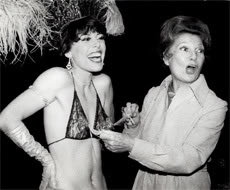 One of the reasons many people still don't know what to say when their sister or co-worker or mom says she's taking an exotic dance or pole fitness class is because many of us only associate what they're saying with one thing: strip clubs – low or highbrow, they are the places where women dance for men who pay them. But exotic dance has a long history, much of it grounded in religious fertility rites (Egypt) or entertainment (Vaudeville and Burlesque).
One of the reasons many people still don't know what to say when their sister or co-worker or mom says she's taking an exotic dance or pole fitness class is because many of us only associate what they're saying with one thing: strip clubs – low or highbrow, they are the places where women dance for men who pay them. But exotic dance has a long history, much of it grounded in religious fertility rites (Egypt) or entertainment (Vaudeville and Burlesque).
According to striptease historians Rachel Shteir, author of “Striptease: The Untold History of the Girlie Show,” the first recorded act of undressing as entertainment occurred in France in the late 1890s. According to Shteir, two women danced and undressed in a half performance during a late night ball near the Moulin Rouge. The floating ball's theme was “Cleopatra” and the women performed their westernized imitation of the “dance du ventre,” or the belly dance. The performance caused a scandal and the women and one of the ball's organizers were fined. A little over a year later, according to Shteir, “undressing acts exploded into the music hall scene,” in France.
]
The seductive movement that the French women performed atop the floating ball was probably a bad imitation of the “raqs sharqi” (Eastern dance) which was introduced to Parisians in 1889 at the International Parisian World Fair. Featured among the attractions at the fair was a performance by a group of women in a reconstructed Cairo Street of Egypt. They drew the attention of visitors because they moved their midriffs, causing the French to rename the ethnic dance, “dance du ventre” or belly dance. Looking for a way to capitalize on an American obsession with the “Orient,” American entrepreneur Sol Bloom bought the rights to the Cairo street exhibit and showcased it at the 1893 Chicago World's Fair. Americans pertaining to the strict, puritanical social order of the day were intrigued because the women moved their middles and were corset-free. The “belly dance” itself has various competing historical origins.
According to Lucinda Jarrett, author of “Stripping in Time,” the dance was originally a sacred fertility dance performed by Ancient Egyptians in the temples. Others say it originated among the Roma people or that it was a birthing dance performed in Egypt.
The Chicago exhibit raised eyebrows and caused a scandal, prompting more visitors and more money. Soon, popular burlesque and vaudeville shows of the day incorporated the belly dance, once again renamed ignorantly by Bloom as the “Hootchy Kootchy,” into their performances. Belly dance historians fume that the family-friendly “eastern” or “oriental” dances of the middle-east were seized upon by world's fair promoters in France and in the U.S. and co-opted as a symbol of unbridled exotic sensuality. The dance was also the subject of some of Thomas Edison's first films. Theater culture, according to Shteir, became increasingly sexualized during the 1930s and 40s. “The mainstreaming of stripping in the 1940s and 50s, plus the appearance of Playboy and the pin-up after the war, and finally the sexual revolution, all brought a death to the tease,” she says. This then “resulted in the appearance of strip clubs as we know them.”

